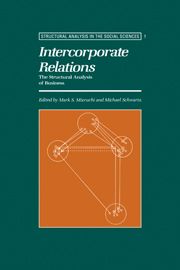Book contents
- Frontmatter
- Contents
- List of figures
- List of tables
- Introduction
- I Theoretical perspectives
- 1 A resource dependence perspective on intercorporate relations
- 2 Finance capital and the internal structure of the capitalist class in the United States
- 3 A structural approach to markets
- 4 What is money? A social structural interpretation
- 5 Corporation, class, and city system
- II National and international business structures: a comparative perspective
- Index of authors
- Subject index
3 - A structural approach to markets
Published online by Cambridge University Press: 04 February 2010
- Frontmatter
- Contents
- List of figures
- List of tables
- Introduction
- I Theoretical perspectives
- 1 A resource dependence perspective on intercorporate relations
- 2 Finance capital and the internal structure of the capitalist class in the United States
- 3 A structural approach to markets
- 4 What is money? A social structural interpretation
- 5 Corporation, class, and city system
- II National and international business structures: a comparative perspective
- Index of authors
- Subject index
Summary
Structural analysis focusses upon the patterns of relationships among social actors. This emphasis rests on the often unspoken postulate that these patterns – independent of the content of the ties – are themselves central to individual action. Moreover, structural analysis posits that the constraints associated with positions in a network of relationships are frequently more important in determining individual action than either the information or attitudes people hold (Berkowitz, 1982: 8).
Structural context is represented by patterns of ties of varying content, and the analyst's interest is in how individual behavior serves to reproduce the structural context (Burt, 1982). The discovery of “self-reproducing” structural contexts has occupied structural analysts in such diverse areas as kinship systems (White, 1963), organizational structures (Kanter, 1977), world systems (Snyder and Kick, 1979; Love 1982; Breiger, 1981) and abstract social structures (Lorrain and White, 1971). In this endeavor structures are “explained” when their self-reproducing properties – and therefore their continued existence – are analytically understood.
This approach contrasts sharply with information-oriented approaches, which explain the existence and/or continuation of a particular structure by showing how it is more “efficient” (in terms of a set of defined goals) than any available alternative (Williamson, 1975). Only efficient structures are likely to be empirically observed, because inefficient structures would perish through natural selection or be made more efficient through the “maximizing” efforts of interested individuals. Structural approaches, on the other hand, identify a self-perpetuating system of structural constraints, without stepping within the kind of information framework needed to assess efficiency.
- Type
- Chapter
- Information
- Intercorporate RelationsThe Structural Analysis of Business, pp. 85 - 108Publisher: Cambridge University PressPrint publication year: 1988
- 5
- Cited by



